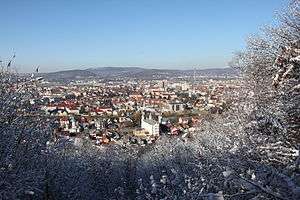Bistrița
Bistrița is the capital of Bistrița-Năsăud County in northern Transylvania, Romania.

Understand
Bistriţa was founded in the early 13th century by German settlers and (due to its location on the main trading route with Moldavia) became one of Transylvania's major Medieval cities. Several interesting sites from that time survive in the city's old quarter. Some tourists are also attracted by the fact that the town was mentioned in Bram Stoker's novel Dracula.
Get in
By train
Bistriţa is on a secondary railway and gets limited service: a few local trains, three commuter trains from Cluj (a three hours trip) and a night train from Bucharest (nine hours) via Brasov . Timetables can be found on the website of the railway operator CFR.
By car
Bistriţa is located on the DN17 road linking Transylvania with Southern Bucovina.
Get around
The relatively compact old quarter can be visited on foot. The rest of the city is covered by several minibus lines operated by Transmixt.
See
Landmarks
- Turnul Dogarilor (Cooper's tower), strada Dogarilor nr. 18. One of the few remaining parts of Bistriţa's medieval fortifications, it now houses a dolls and masks museum
- Sugălete (Sugălete row), Piaţa Centrală. A group of thirteen connected homes built in the 14th-16th centuries
- Casa Ion Zidaru, Piaţa Centrală nr. 30. One of the best examples of late Gothic architecture in Transylvania
- Casa Argintarului (Silversmith's house), strada Dornei nr. 5. A beautiful 16th century Renaissance house
Religious sites
- Biserica Evanghelică (Evangelical church), Piaţa Centrală. First built in the second half of the 14th century, has one of the highest Gothic towers in Transylvania
- Biserica Intrarea Maicii Domnului în Biserică (Presentation of the Virgin Mary church), Piaţa Unirii. A former Catholic monastery built in the late 13th century, now an Orthodox church
- Sinagoga (The synagogue), strada General Grigore Bălan nr. 10. Built in 1856 by the once thriving Jewish community
Museums
- Muzeul judeţean Bistriţa Năsăud (Bistriţa Năsăud county museum), strada General Grigore Bălan nr. 19. Tu-Su 10AM-6PM (summer), 9AM-5PM (winter). Has ethnography, art, archeology, historical and geology collections
Do
Buy
Eat
Drink
Sleep
Budget
- Pensiunea Sheriff, DN17 nr. 252A (in Unirea suburb), ☎ +40 263 228121. €14-55.
- Pensiunea Miracolo, DN17 nr. 445 (in Unirea suburb), ☎ +40 263 228048, e-mail: pensiune@miracolo.ro. €15-28.
- Hotel Minerva, Strada Compozitorilor nr.2, ☎ +40 263 234156, e-mail: rezervari@hotel-minerva.ro. €21-35.
Mid-range
- Hotel Diana, Calea Moldovei nr. 80, ☎ +40 263 231960, fax: +40 263 231961, e-mail: dianahotel@dianahotel.ro. Check-in: 14.00, check-out: 12.00. €31-53.
- Hotel Codrisor, Strada Codrişor nr. 28, ☎ +40 263 233814, fax: +40 263 236476, e-mail: hotel@hotelcodrisor.ro. €27-62.
- Hotel Bistrita, Piaţa Petru Rareş nr.2, ☎ +40 263 231154, fax: +40 263 231826, e-mail: hotel@hotel-bistrita.ro. €36-84.
- Hotel Coroana de Aur (The Golden Crown Hotel), Piaţa Petru Rareş nr.4, ☎ +40 263 232470, fax: +40 263 232667. Check-in: 14.00, check-out: 12.00. €31-107.